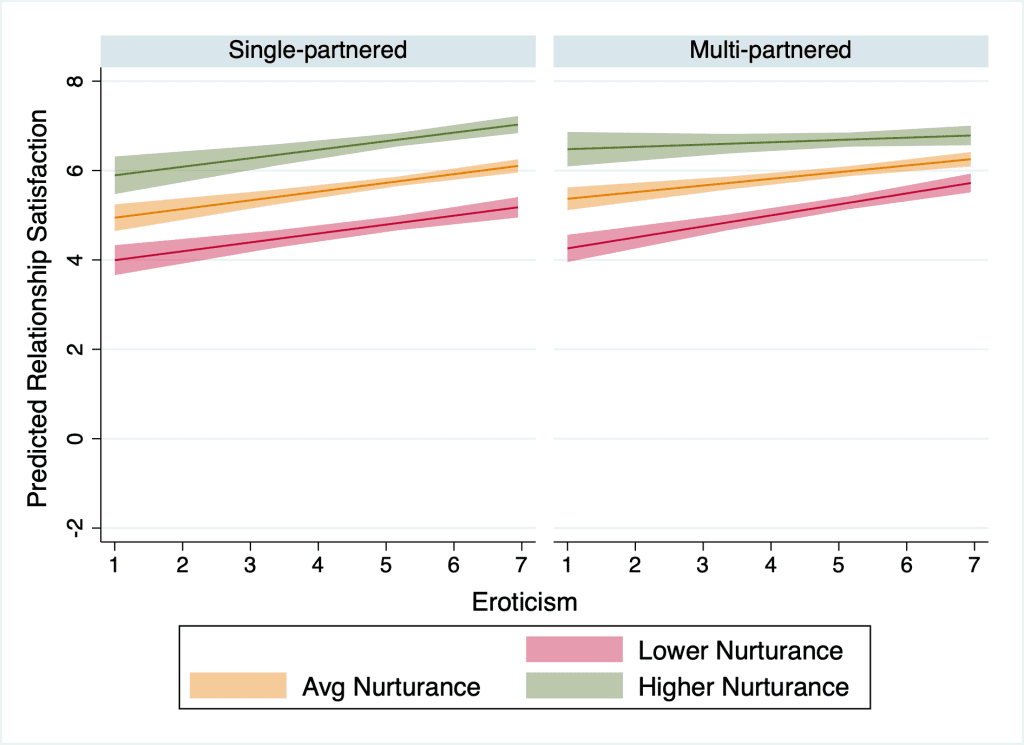Michelle Larva
How satisfied we feel in intimate relationships affects many aspects of our lives. The key indicators of satisfying, fulfilling relationships—many relationship science theorists have countlessly argued—lie in adequate levels of nurturance and eroticism.
Often we might assume that we need plenty of both eroticism and nurturance simultaneously in order to have a satisfying relationship. Increasing public discourse on alternative relationship forms within consensual non-monogamy (CNM) raises an important question: are eroticism and nurturance equally important when additional partners are in the mix? Forms of consensual non-monogamy include polyamory and open relationships, for example.
For ease of reading, I have expanded the keywords at the end of the article.
About the Study
As part of my doctoral research within INVEST Psychology on which factors contribute to personal and relational wellbeing in CNM relationships, I—together with my colleagues Dr. Justin Mogilski from the University of South Carolina Salkehatchie, and Dr. Shari Blumenstock from the Queen’s University and the Kinsey Institute at Indiana University Bloomington—assessed whether nurturance, eroticism, and relationship type would interact in their association with relationship satisfaction. The results of this study were presented at the Society for the Scientific Study of Sexuality conference in November 2023[1] and are pending submission for peer review and publication.
In our study, 611 monogamous and CNM participants from Finland, Poland, Portugal, Italy, the US, and Brazil, completed an online survey about their relationship structure, relationship satisfaction, and how much their relationship was characterized by eroticism and nurturance. To analyze the association for individuals with multiple partners, we used data from the first partner (often identified as the primary partner) for whom the participants provided responses.
Differences in the significance of nurturance and eroticism in single- and multi-partnered relationships
Overall, our results suggest that nurturance is a stronger predictor of relationship satisfaction than eroticism across all types of relationships, but also that nurturance and eroticism are differently associated with relationship satisfaction for individuals with one partner compared to those with multiple partners.
For people with one partner, nurturance and eroticism are positively and independently associated relationship satisfaction. That is, how strongly nurturance and relationship satisfaction are related does depend on the level of eroticism in the relationship. The reverse applies as well; the association between eroticism and relationship satisfaction does not vary with the level of nurturance in the relationship.
For those with more than one partner, however, nurturance and eroticism interact in how they are positively associated with relationship satisfaction. The level of nurturance in the relationship is a stronger predictor of relationship satisfaction when there is less eroticism; the lower the level of eroticism, the more important it is to have a high level of nurturance for optimal relationship satisfaction. Eroticism, on the other hand, is only marginally associated with satisfaction, becoming a stronger predictor only when there is a low level of nurturance in that relationship.
Dynamics of multi-relationships important to account for when studying relationship satisfaction
Prior research has shown that people in CNM relationships have similar relationship quality as those in monogamous relationships, and that they experience different levels of eroticism and nurturance with primary vs secondary partners[2][3][4][5]. Hence, it is possible that people gain different things out of different relationships and can therefore feel satisfied in one relationship which may lack one aspect while being abundant in the other[6]. Alternatively, it may be that people in CNM relationships simply have different expectations of their relationships and are thus differentially satisfied compared to people who are monogamously partnered.
These results imply that individuals may find their relationship with their primary partner to be satisfying despite a lack of eroticism if they have multiple romantic/sexual partners. It also may suggest that assessments of relationship satisfaction and quality in future research may need to consider how CNM dynamics impact these measures.


Key Terms:
- Consensual Non-monogamy is an umbrella term for relationship structures in which individuals seek and obtain the informed consent of their partner to have extra-dyadic sexual and/or romantic relations.[7]
- Nurturance can be described as aspects of warm, loving feelings, closeness, deep intimacy, and commitment. Eroticism relates to aspects of sexuality tied to pleasure and arousal. Both serve fundamental roles in intimate relationships. Individuals may pursue intimate relationships for eroticism, for nurturance, or for both.[8]
- A primary partner can be defined as a partner that is considered as holding high significance in multi-partner contexts. Often the primary relationship is marked by high levels of commitment and intimacy.[9] Some CNM individuals do not consider any of their partners as primary, while others may have multiple primary partners.
The writer is a doctoral researcher in the INVEST Research Flagship Centre. - [1] Slides stored in OSF https://osf.io/ur3we
- [2] Rodrigues, D. L., Lopes, D., & Pereira, M. (2016). “We agree and now everything goes my way”: Consensual sexual nonmonogamy, extradyadic sex, and relationship satisfaction. Cyberpsychology, Behavior, and Social Networking, 19, 373– 379. https://doi.org/10.1089/cyber.2016.0114
- [3] Rodrigues, D. L., Lopes, D., Pereira, M., de Visser, R., & Cabaceira, I. (2019). Sociosexual attitudes and quality of life in (non)monogamous relationships: The role of attraction and constraining forces among users of the Second Love web site. Archives of Sexual Behavior, 48, 1795– 1809. https://doi.org/10.1007/s10508-018-1272-x
- [4] Rodrigues, D. L., Lopes, D., & Smith, C. V. (2017). Caught in a “bad romance”? reconsidering the negative association between sociosexuality and relationship functioning. The Journal of Sex Research, 54(9), 1118–1127. https://doi.org/10.1080/00224499.2016.1252308
- [5] Rubel, A. N., & Bogaert, A. F. (2015). Consensual nonmonogamy: Psychological well- being and relationship quality correlates. Journal of Sex Research, 52, 961– 982. https://doi.org/10.1080/00224499.2014.942722
- [6] Balzarini, R. N., Dharma, C., Muise, A., & Kohut, T. (2019). Eroticism versus nurturance: How eroticism and nurturance differs in polyamorous and monogamous relationships. Social Psychology, 50(3), 185–200. https://doi.org/10.1027/1864-9335/a000378
- [7] Taivaloja, N. (2022). Ammattilainen: Tutustu monisuhteisuus-aapiseen! https://nitataivaloja.fi/onko-monisuhteisuus-aapinen-jo-tuttu/
- [8] van Anders, S. M. (2015). Beyond sexual orientation: Integrating gender/sex and diverse sexualities via sexual configurations theory. Archives of Sexual Behavior, 44, 1177–1213. http//doi.org/10.1007/s10508-015-0490-8
- [9] Polyamoria ja monisuhteisuus ry. (2024). Sanasto. https://polyamoria.fi/tietoa/sanasto/





